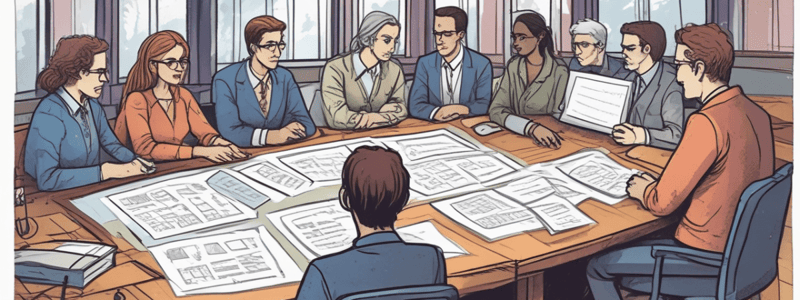Podcast
Questions and Answers
What is the main benefit of students co-developing rubrics for assessment?
What is the main benefit of students co-developing rubrics for assessment?
- It enables students to take ownership of the assessment process. (correct)
- It allows students to bypass teacher involvement.
- It eliminates the need for peer assessment.
- It simplifies the assessment criteria for teachers.
How does self-assessment contribute to a student's learning process?
How does self-assessment contribute to a student's learning process?
- It encourages students to copy their peers.
- It helps students identify their weaknesses and strengths. (correct)
- It allows students to judge their peers' work.
- It replaces the need for teacher assessment.
What is a key feature of effective rubrics in the assessment process?
What is a key feature of effective rubrics in the assessment process?
- They are fixed and do not allow for student input.
- They include complex language that complicates understanding.
- They provide clear criteria that students can align with their learning objectives. (correct)
- They are based solely on instructor preferences.
Which of the following describes a benefit of peer assessment?
Which of the following describes a benefit of peer assessment?
What role does self-regulation play in the assessment process?
What role does self-regulation play in the assessment process?
What role do contracts play in team collaboration?
What role do contracts play in team collaboration?
What is the primary focus of assessment in a STEM PBL environment?
What is the primary focus of assessment in a STEM PBL environment?
What differentiates critical assessment criteria from tangential ones?
What differentiates critical assessment criteria from tangential ones?
How does teacher behavior affect student learning?
How does teacher behavior affect student learning?
Why is feedback essential for teachers in STEM education?
Why is feedback essential for teachers in STEM education?
Flashcards are hidden until you start studying
Study Notes
Reflection Assessments
- Reflection assessments include self-reflections and reflections on team collaboration, found in Appendices Q and R.
- Contracts, both social and intellectual, can guide individual accountability and establish common goals between teachers and students.
Group Contracts
- Contracts can specify group behaviors and are negotiated between group members or between a teacher and students.
- Appendix O includes a completed contract example along with various editable contract types to suit classroom needs.
Importance of Individualized Assessment
- Assessments should align with state-level tasks to prepare students for high-stakes testing.
- Educational innovations must show measurable impact on high-stakes assessments to be successful.
Authentic vs. High-Stakes Assessment
- Striking a balance between authentic assessments (focused on skills like designing and synthesizing) and high-stakes assessments is crucial for individual accountability.
Rubrics in Assessment
- The book includes various rubrics designed to enhance assessment, addressing questions related to future application and understanding of material.
- Effective rubrics help in reflecting student accountability through thoughtful design and application.
Self-Regulation
- Explicit assessments enhance student self-regulation, with two levels of involvement.
- The first level involves students co-developing rubrics, promoting ownership and clarity in evaluation standards.
Peer and Self-Assessment
- The second level occurs through peer- and self-assessment using developed rubrics, leading to recognition of strengths and weaknesses.
- This process encourages responsibility for learning outcomes rather than compliance with teacher expectations.
Informational Feedback
- Peer assessment and feedback can bolster student self-regulation by providing opportunities for improvement in a non-competitive environment.
- Successful implementation of self-assessment may require teacher guidance and repeated practice.
Formative Assessment of Teachers
- Teacher performance in STEM PBL should also be assessed formatively to improve education quality.
- The Aggie STEM teacher assessment instrument is designed for criteria-specific feedback rather than summative evaluation.
Impact of Teacher Behavior
- Teacher behavior and instructional approaches significantly affect student learning.
- Research indicates ineffective teaching can lower student achievement, emphasizing the need for classroom observation to gauge professional development effectiveness.
Studying That Suits You
Use AI to generate personalized quizzes and flashcards to suit your learning preferences.



